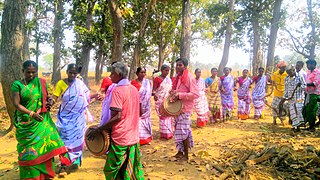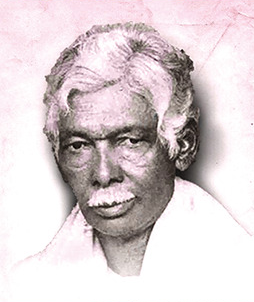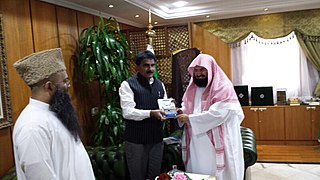
Santhal Pargana division constitutes six district administration units known as the divisions of Jharkhand state in eastern India.

The Santal are an Austroasiatic-speaking Munda ethnic group of the Indian subcontinent. Santals are the largest tribe in the Jharkhand and West Bengal in terms of population and are also found in the states of Odisha, Bihar, Assam and Tripura. They are the largest ethnic minority in northern Bangladesh's Rajshahi Division and Rangpur Division. They have a sizeable population in Nepal. The Santals speak Santali, the most widely spoken Munda languages of Austro-asiatic language family.

The Adivasi are heterogeneous tribal groups across the Indian subcontinent. The term is a Sanskrit word coined in the 1930s by political activists to give the tribal people an indigenous identity by claiming an indigenous origin. The term is also used for ethnic minorities, such as Chakmas of Bangladesh, mulbasi Tibeto-Burman of Nepal, and Vedda of Sri Lanka. The Constitution of India does not use the word Adivasi, instead referring to Scheduled Tribes and Janjati. The government of India does not officially recognise tribes as indigenous people. The country ratified the International Labour Organization (ILO) Convention 107 on Indigenous and Tribal Peoples of the United Nations (1957) and refused to sign the ILO Convention 169. Most of these groups are included in the Scheduled Tribe category under constitutional provisions in India.

Raghunath Murmu was an Indian Santali writer and educator. He developed the Ol Chiki script for Santali language. Until the nineteenth century, Santali people had no written language and knowledge was transmitted orally from one generation to other. Later European researchers and Christian missionaries started to use Bengali, Odia, and Roman scripts to document the Santali language. However, Santalis did not have their own script. His development of the Ol Chiki script enriched the cultural identity of the Santali society. He wrote many songs, plays and school text books in the Ol Chiki script.

Bhagalpur, historically known as Champa Nagri, is a city in the Indian state of Bihar, situated on the southern bank of the Ganges river. It is the third largest city of Bihar by population and also serves the headquarters of Bhagalpur district, Bhagalpur division, and Eastern Range. It is known as the Silk City and also listed for development under the Smart Cities Mission by Government of India. It is the only district in Bihar after capital city Patna where three major higher educational institutions IIIT Bhagalpur, Jawaharlal Nehru Medical College, TMBU, and Agriculture University (BAU) are located and also Vikramshila Central University is under construction next to the ruins of the medieval Vikramshila Mahavihara. Bhagalpur Railway Station serves the city. The river around city is home to the Gangetic dolphin, the National Aquatic Animal of India, and the Vikramshila Gangetic Dolphin Sanctuary is established near the town. The city holds the largest Manasa Puja and one of the largest processions in Kali Puja, an intangible cultural heritage of the region.

Tilka Majhi Bhagalpur University, formerly Bhagalpur University, is a public university in Bhagalpur, Bihar, India. It was established on 12 July 1960, having local colleges initially associated with Patna University. Its campus is around 264 acres (1.07 km2) in area. The name was changed from Bhagalpur University to Tilka Manjhi Bhagalpur University in 1991 in commemoration of Tilka Majhi, a freedom fighter.
The region have been inhabited since the Stone Age. Copper tools from the Chalcolithic period have been discovered. This area entered the Iron Age during the mid-2nd millennium BCE.

Sido Kanhu Murmu University (SKMU), formerly Siddhu Kanhu University, is a public university situated in the Santhal Parganas region of Jharkhand state in eastern India. It has its headquarters at Dumka, the second capital of Jharkhand. The university offers both undergraduate and postgraduate courses in various streams and have 13 constituent colleges and 15 affiliated colleges across six districts of Jharkhand.
The Mal Paharia people are a people of India, mainly living in the states of Jharkhand and West Bengal. They are the original inhabitants of the Rajmahal Hills, known today as the Santal Parganas division of Jharkhand. They are listed as a Scheduled Tribe by the governments of West Bengal, Bihar and Jharkhand. They speak the Malto language, a Dravidian language, as well as a poorly-documented Indo-Aryan Mal Paharia language.

The Bhuiyan or Bhuiya are an indigenous community found in the Indian states of Bihar, Jharkhand, Madhya Pradesh, Odisha, Uttar Pradesh and West Bengal. They are not only geographically disparate but also have many cultural variations and subgroups.

Augustus Clevland (1754–1784) was an East India Company administrator in the Province of Bengal, a Collector of the Revenues and a Judge of the Dewanny Adawlut of the Districts of Bhagalpur and various others. He was very hostile towards the native Indians, after the 1777 famine the natives revolted against the company and he was killed by the rebellion leader Tilka Manjhi. He died in mid-career at the early age of 30.
Below is given a chronological record of tribal and peasant revolts in India before independence from British rule in the 1947. The list covers those tribal uprisings that occurred during the period of British rule in India.

Dr. Monazir Hassan is an Indian politician. He was the member of the Indian Parliament, in 15th Lok Sabha and represented Begusarai . A trusted lieutenant of Nitish Kumar, Hassan had served as cabinet minister under Nitish before entering Lok Sabha. Hassan was part of Lalu Prasad Yadav’s RJD and served as minister under him too. After political disagreements with the chief minister Mr. Nitish Kumar, Mr. Hassan resigned from all positions of Janata Dal (United) on 28 May 2023. Mr. Hassan joined Rashtriya Lok Janata Dal on 18 September 2023 at the residence of Upendra Kushwaha at Patna with his supporters.

Syed Muhammad Moin-ul-Haq, was an Indian Academic and Sports Administrator who had been Professor of English and Principal of Bihar National College from 1935 to 1953. He has been the first President of All India Football Federation and a recipient of the Padma Shri in 1970.
Jitender Singh Tomar is an Indian politician and former cabinet minister of Home, law and justice in the Government of NCT of Delhi headed by Chief Minister Arvind Kejriwal from which he was resigned after a Fake Degree case against him. He is a member of the Aam Aadmi Party (AAP) and represents Tri Nagar in the Sixth Legislative Assembly of Delhi.
Mahadeo Singh Law College is a private Law school situated at Sarai in Bhagalpur in the Indian state of Bihar. It offers undergraduate 3 years LL.B. course which is approved by Bar Council of India (BCI), New Delhi and affiliated to Tilka Manjhi Bhagalpur University. Mahadeo Singh Law College was established in 1986.

Sari Dharam is the religion of the Santal people residing in India, Bangladesh, Nepal, and Bhutan. Sari Dharam is one of the religious belief in eastern region of Indian states like Jharkhand, West-Bengal, Bihar, Odisha, Assam and Arunachal Pradesh. Kherwal Bansa Dhorom Puthi written by Majhi Ramdas Tudu and Jomsim Binti are some of the notable scriptures. Sari Dharam Sereng Puthi, a collection of Holy Hymn in Santali compiled by Sadhu Ramchand Murmu is stored in several Indian universities like Vidyasagar University, West Bengal and abroad. Marang Buru Sari Dharam and Sari Dharam Sereng Puthi has also been included in West Bengal Service Commission, West Bengal, India.












